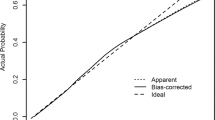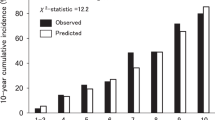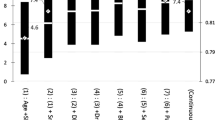Abstract
Trends in incidence and prevalence of hypertension are grave in China and identifying high-risk, non-hypertension individuals for intervention may delay hypertension onset. We aimed to investigate the incidence of hypertension in northern urban Han Chinese population and construct multivariable hypertension prediction models through the prospective cohort, which included 7537 men and 4960 women free of hypertension at baseline between 2005 and 2010. During 38 958 person-years of follow-up, 2785 participants (men, 72.57%; women, 27.43%) developed hypertension. The incidence density of hypertension was 71.48 per 1000 person-year. In multivariable backward cox analyses, age, body mass index, systolic blood pressure (SBP), diastolic blood pressure (DBP), fasting blood glucose and current drinking were retained for both men and women, while gamma-glutamyl transferase only for men, total cholesterol, neutrophil granulocyte and current smoking only for women. The area under receiver operating characteristic curve (AUC) was 0.761 (95% confidence interval (CI), 0.752–0.771) for men and 0.753 (95% CI, 0.741–0.765) for women, even after 10-fold cross-validation, the AUC was 0.760 (95% CI, 0.751–0.770) for men and 0.749 (95% CI, 0.737–0.761) for women. Through risk stratification, the absolute risk of incident hypertension in 5 years at moderate, high and very high risk level was 2.13, 3.84 and 6.14 times that of those who were at low risk in men, and 1.30, 2.56 and 6.01 times that of those who were at low risk in women. Our findings identified predictors of incident hypertension and indicated that the sex-specific multivariable prediction models would be simply used to estimate the risk of incident hypertension.
This is a preview of subscription content, access via your institution
Access options
Subscribe to this journal
Receive 12 digital issues and online access to articles
$119.00 per year
only $9.92 per issue
Buy this article
- Purchase on Springer Link
- Instant access to full article PDF
Prices may be subject to local taxes which are calculated during checkout


Similar content being viewed by others
References
Alwan A . Global Status Report on Noncommunicable Diseases 2010. World Health Organization: Geneva, Switzerland, 2011.
Lim SS, Vos T, Flaxman AD, Danaei G, Shibuya K, Adair-Rohani H et al. A comparative risk assessment of burden of disease and injury attributable to 67 risk factors and risk factor clusters in 21 regions, 1990–2010: a systematic analysis for the Global Burden of Disease Study 2010. Lancet 2013; 380: 2224–2260.
Chobanian AV, Bakris GL, Black HR, Cushman WC, Green LA, Izzo JL Jr et al. The seventh report of the joint national committee on prevention, detection, evaluation, and treatment of high blood pressure: the JNC 7 report. JAMA 2003; 289: 2560–2571.
Liang Y, Liu R, Du S, Qiu C . Trends in incidence of hypertension in Chinese adults, 1991-2009: the China Health and Nutrition Survey. Int J Cardiol 2014; 175: 96–101.
Xi B, Liang Y, Reilly KH, Wang Q, Hu Y, Tang W . Trends in prevalence, awareness, treatment, and control of hypertension among Chinese adults 1991-2009. Int J Cardiol 2012; 158: 326–329.
Wang J, Zhang L, Wang F, Liu L, Wang H . Prevalence, awareness, treatment, and control of hypertension in China: results from a national survey. Am J Hypertens 2014; 27: 1355–1361.
Parikh NI, Pencina MJ, Wang TJ, Benjamin EJ, Lanier KJ, Levy D et al. A risk score for predicting near-term incidence of hypertension: the Framingham Heart Study. Ann Intern Med 2008; 148: 102–110.
Liu J, Hong Y, D’Agostino RB Sr, Wu Z, Wang W, Sun J et al. Predictive value for the Chinese population of the Framingham CHD risk assessment tool compared with the Chinese Multi-Provincial Cohort Study. JAMA 2004; 291: 2591–2599.
D’Agostino RS, Grundy S, Sullivan LM, Wilson P . Validation of the Framingham coronary heart disease prediction scores: results of a multiple ethnic groups investigation. JAMA 2001; 286: 180–187.
Zheng L, Sun Z, Zhang X, Li J, Hu D, Chen J et al. Predictive value for the rural Chinese Population of the Framingham hypertension risk model: results from Liaoning province. Am J Hypertens 2014; 27: 409–414.
Li G, Liu J, Wang W, Wang M, Xie W, Hao Y et al. [Prediction models for the 15 years risk of new-onset hypertension in Chinese people aged from 35 to 64 years old]. Zhonghua Nei Ke Za Zhi 2014; 53: 265–268.
Chien KL, Hsu HC, Su TC, Chang WT, Sung FC, Chen MF et al. Prediction models for the risk of new-onset hypertension in ethnic Chinese in Taiwan. J Hum Hypertens 2011; 25: 294–303.
Wang LD . Nutrition and Health Status in Chinese People. Beijing CN People’s Publishing House: Beijing, China, 2005.
Wu X, Duan X, Gu D, Hao J, Tao S, Fan D . Prevalence of hypertension and its trends in Chinese populations. Int J Cardiol 1995; 52: 39–44.
Liu LS . [2010 Chinese guidelines for the management of hypertension]. Zhonghua Xin Xue Guan Bing Za Zhi 2011; 39: 579–615.
Lee JS, Kawakubo K, Kashihara H, Mori K . Effect of long-term body weight change on the incidence of hypertension in Japanese men and women. Int J Obes Relat Metab Disord 2004; 28: 391–395.
Zhang H, Thijs L, Kuznetsova T, Fagard RH, Li X, Staessen JA . Progression to hypertension in the non-hypertensive participants in the Flemish Study on environment, genes and health outcomes. J Hypertens 2006; 24: 1719–1727.
Vasan RS, Larson MG, Leip EP, Kannel WB, Levy D . Assessment of frequency of progression to hypertension in non-hypertensive participants in the Framingham Heart Study: a cohort study. Lancet 2001; 358: 1682–1686.
Benetos A, Waeber B, Izzo J, Mitchell G, Resnick L, Asmar R et al. Influence of age, risk factors, and cardiovascular and renal disease on arterial stiffness: clinical applications. Am J Hypertens 2002; 15: 1101–1108.
Franklin SS, Gustin WT, Wong ND, Larson MG, Weber MA, Kannel WB et al. Hemodynamic patterns of age-related changes in blood pressure. The Framingham Heart Study. Circulation 1997; 96: 308–315.
Kivimaki M, Batty GD, Singh-Manoux A, Ferrie JE, Tabak AG, Jokela M et al. Validating the Framingham Hypertension Risk Score: results from the Whitehall II study. Hypertension 2009; 54: 496–501.
Nyamdorj R, Qiao Q, Soderberg S, Pitkaniemi J, Zimmet P, Shaw J et al. Comparison of body mass index with waist circumference, waist-to-hip ratio, and waist-to-stature ratio as a predictor of hypertension incidence in Mauritius. J Hypertens 2008; 26: 866–870.
Recio-Rodriguez JI, Gomez-Marcos MA, Patino-Alonso MC, Agudo-Conde C, Rodriguez-Sanchez E, Garcia-Ortiz L . Abdominal obesity vs general obesity for identifying arterial stiffness, subclinical atherosclerosis and wave reflection in healthy, diabetics and hypertensive. BMC Cardiovasc Disord 2012; 12: 3–11.
Kshirsagar AV, Chiu YL, Bomback AS, August PA, Viera AJ, Colindres RE et al. A hypertension risk score for middle-aged and older adults. J Clin Hypertens Greenwich 2010; 12: 800–808.
Stranges S, Wu T, Dorn JM, Freudenheim JL, Muti P, Farinaro E et al. Relationship of alcohol drinking pattern to risk of hypertension a population-based study. Hypertension 2004; 44: 813–819.
Okubo Y, Sairenchi T, Irie F, Yamagishi K, Iso H, Watanabe H et al. Association of alcohol consumption with incident hypertension among middle-aged and older Japanese Population: the Ibarakai Prefectural Health Study (IPHS). Hypertension 2014; 63: 41–47.
Title LM, Cummings PM, Giddens K, Nassar BA . Oral glucose loading acutely attenuates endothelium-dependent vasodilation in healthy adults without diabetes: an effect prevented by vitamins C and E. J Am Coll Cardiol 2000; 36: 2185–2191.
Ceriello A, Quatraro A, Giugliano D . Diabetes mellitus and hypertension: the possible role of hyperglycaemia through oxidative stress. Diabetologia 1993; 36: 265–266.
Ferrannini E, Buzzigoli G, Bonadonna R, Giorico MA, Oleggini M, Graziadei L et al. Insulin resistance in essential hypertension. N Engl J Med 1987; 317: 350–357.
Stranges S, Trevisan M, Dorn JM, Dmochowski J, Donahue RP . Body fat distribution, liver enzymes, and risk of hypertension: evidence from the Western New York Study. Hypertension 2005; 46: 1186–1193.
Lee DH, Jacobs DJ, Gross M, Kiefe CI, Roseman J, Lewis CE et al. Gamma-glutamyltransferase is a predictor of incident diabetes and hypertension: the Coronary Artery Risk Development in Young Adults (CARDIA) Study. Clin Chem 2003; 49: 1358–1366.
Rosendorff C . Hypertension: mechanisms and diagnosis. Essential Cardiology. Springer, New York, 2013, 543–559.
Tatsukawa Y, Hsu WL, Yamada M, Cologne JB, Suzuki G, Yamamoto H et al. White blood cell count, especially neutrophil count, as a predictor of hypertension in a Japanese population. Hypertens Res 2008; 31: 1391–1397.
Sela S, Mazor R, Amsalam M, Yagil C, Yagil Y, Kristal B . Primed polymorphonuclear leukocytes, oxidative stress, and inflammation antecede hypertension in the Sabra rat. Hypertension 2004; 44: 764–769.
Ling R, Liu F, Lu X, Wang W . Emerging issues in public health: a perspective on China’s healthcare system. Public Health 2011; 125: 9–14.
Acknowledgements
This work was supported by grants from the National Nature Science Foundation (No. 81273082) of China and funded by Taishan industrial expert program. The founders were not involved in study design, analysis and interpretation. We would like to thank all subjects who participated in the study.
Author information
Authors and Affiliations
Corresponding authors
Ethics declarations
Competing interests
The authors declare no conflict of interest.
Additional information
Supplementary Information accompanies this paper on the Journal of Human Hypertension website
Supplementary information
Rights and permissions
About this article
Cite this article
Chen, Y., Wang, C., Liu, Y. et al. Incident hypertension and its prediction model in a prospective northern urban Han Chinese cohort study. J Hum Hypertens 30, 794–800 (2016). https://doi.org/10.1038/jhh.2016.23
Received:
Revised:
Accepted:
Published:
Issue Date:
DOI: https://doi.org/10.1038/jhh.2016.23
This article is cited by
-
Development of hypertension models for lung cancer screening cohorts using clinical and thoracic aorta imaging factors
Scientific Reports (2024)
-
A comparison of machine learning algorithms and traditional regression-based statistical modeling for predicting hypertension incidence in a Canadian population
Scientific Reports (2023)
-
Hypertension risk prediction models for patients with diabetes based on machine learning approaches
Multimedia Tools and Applications (2023)
-
Development and validation of hypertension prediction models: The Korean Genome and Epidemiology Study_Cardiovascular Disease Association Study (KoGES_CAVAS)
Journal of Human Hypertension (2022)
-
Establishment and evaluation of a risk-prediction model for hypertension in elderly patients with NAFLD from a health management perspective
Scientific Reports (2022)



